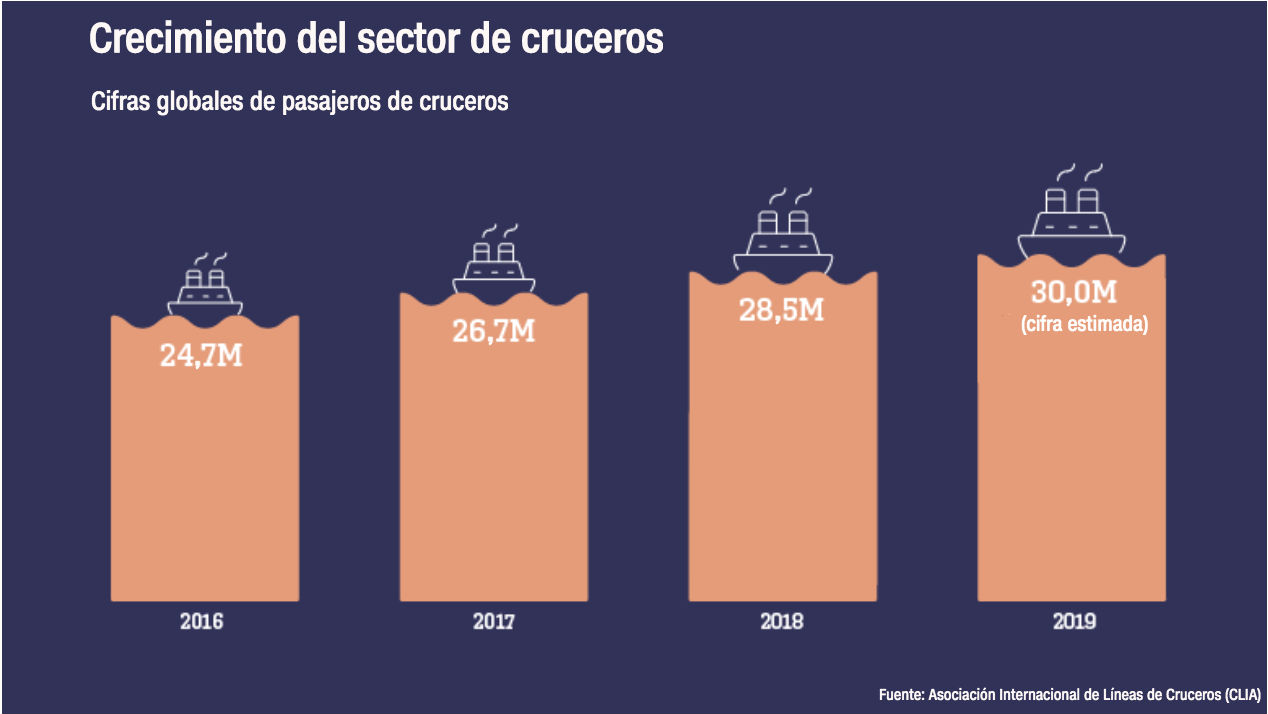The first big cruise with tourists sailed and that's how it went 1:24
(CNN) –– When embarking in the port of Genoa, Italy, for a seven-day Mediterranean cruise on August 16, travel agent Valeria Belardi prepared for a journey like no other.
Belardi was one of 3,000 pioneers aboard MSC Grandiosa, the first cruise ship to return to the Mediterranean after the global shutdown of the multi-billion dollar cruise industry amid the coronavirus pandemic.
The trip was marked by COVID-19 tests, social distancing, hand disinfection and temperature checks, but, Belardi told CNN, it was also relaxing and enjoyable. More importantly, it appeared to be virus-free.
- LEE: I was stranded at sea on a cruise ship. Now they owe me $ 37,000
MSC Cruises did not confirm the exact figures, but the Grandiosa operated at about 60% of its 6,300 passenger capacity.
There were day trips, including sightseeing in Malta's capital Valletta, and the Sicilian city of Palermo. While on board, Belardi enjoyed packaged snacks on deck, relaxing nights by the pool, and a visit to the spa.
"I think cruises could be the safest vacation at the moment," said Belardi, owner of the Vivere & Viaggiare Roma Pittaluga travel company.
But MSC Grandiosa is practically alone on its return to the high seas.
The U.S. Centers for Disease Control and Prevention (CDC) issued a no-sail order that prohibits transit through U.S. waters until at least September 2020.
Major cruise companies, including Princess Cruises, also canceled trips in regions outside of the United States, including Asia, the Caribbean, South America and Antarctica, until mid-December.
This is how cruises return to the Mediterranean 1:19Smaller cruise lines across Europe have resumed operations, with mixed results. Earlier this month, 41 crew members and 21 guests tested positive for COVID-19 after traveling on the small Norwegian cruise ship MS Roald Amundsen.
MSC Cruises is one of the first major companies to venture out onto the waters with a large ship, and cruise industry experts see this as a key test.
The Grandiosa's fare and subsequent scheduled Mediterranean voyages could be an indicator of how cruise ships can safely return to a different world.
Current situation
MSC Grandiosa departing Genoa on August 16. (Credit: MIGUEL MEDINA / AFP via Getty Images)
For the cruise industry, the stakes are incredibly high.
Cruise ships have seen a boom over the past decade, with 30 million passengers in 2019, which created demand for bigger, better and grander ships and a $ 150 billion industry that supports 1.2 million jobs.
That exponential growth caused image problems amid concerns about excessive tourism and environmental impact.
Then came the public relations disaster in the wake of the coronavirus: Cruise ships were deemed high-risk by covid-19 during the spread of the pandemic, after several major outbreaks left ships scrambling to find a safe harbor and crews were left behind. stranded at sea.
The challenge now facing cruise companies around the world is how to recover safely and efficiently while convincing travelers to return.
"We know that for every 1% drop in cruise ships worldwide, up to 9,100 jobs can be lost," Bari Golin-Blaugrund, spokesperson for the Cruise Lines International Association (CLIA, for its acronym in English) told CNN. ), an industry body.
Golin-Blaugrund noted that CLIA is confident that cruises will recover, as demand is already being seen for the 2021 holidays and beyond. However, she says that having most cruise operations still suspended means the loss of up to 2,500 jobs per day.
"By the end of September, the global impact will be $ 77 billion, 518,000 jobs and $ 23 billion in lost wages," he said.
- LOOK: What awaits the cruise industry after the coronavirus crisis?
Among those planning to return to cruise ships is American traveler Christine Beehler, who notes that testing positive for COVID-19 after a trip on the Coral Princess last April has not discouraged her.
"Even without a vaccine, I'm ready to try it," Beehler told CNN last month. "There are so many places I still want to go, and I enjoy sailing."
The new normal
Following her first successful voyage, MSC Grandiosa departed on 23 August for a second test cruise, stopping at the Greek ports of Corfu, Katakolon and Piraeus.
Prior to boarding, MSC Cruises passengers were tested for COVID-19 using a primary antigen test and a secondary molecular test.
MSC Cruises representative Luca Biondolillo told CNN that a passenger who boarded tested positive for both stages.
Covid-19 testing and temperature checks marked the return of the MSC Grandiosa to the water. (Credit: MIGUEL MEDINA / AFP via Getty Images)
"According to the protocol, both the passenger and his travel group were denied boarding," Biondolillo said.
"In addition, other passengers who arrived on the ship in the same van were denied boarding because they were close contacts of the passenger who tested positive," he added.
This response, Biondolillo said, suggests that strict testing is working, successfully eliminating anyone with COVID-19 before getting on the ship.
In addition to the tests, passengers must comply with a temperature control and a health questionnaire. Crew members are also tested for the virus before boarding and, according to MSC Cruises, "regularly during their contract."
On board, cleaning methods have been intensified, including hospital-grade disinfectant and the use of UV-C light technology.
The 70% maximum capacity rule ensures that social distancing is respected, while all activities on board are geared towards smaller groups.
Covid-19, the anchor in the millionaire cruise business 2:36Some cruise experts have come up with the concept of 'cruise to nowhere', which allows guests to enjoy the comforts of life on a ship without the worries of catching the virus in port and spreading it through the ship, or vice versa.
But MSC Cruises decided to stick with port visits, while ensuring that all excursions were planned in advance and strictly controlled.
Biondolillo told CNN that during the MSC Grandiosa voyage on August 16, a family broke the rules during a stop at the port and was subsequently denied boarding.
"Health and safety protocols are implemented for the benefit of each person," he said. "You can't break the rules," he added.
"These people ran the risk of endangering everyone else's vacation and health," he insisted.
Passenger Valeria Belardi took this photograph of passengers relaxing in the pool on the cruise ship. (Credit: Courtesy Vivere & Viaggiare Roma Pittaluga)
Passenger Valeria Belardi indicated that the "strong, detailed and really effective" health and safety measures allowed her to feel relaxed on board.
She described the ship's atmosphere as "peaceful and quiet."
Without a doubt, MSC Cruises' European voyage will be under the scrutiny of the Italian company Costa Cruises, which will send its ship Costa Deliziosa from the Italian city of Trieste on September 6 for a test trip to a number of Italian ports.
MSC and Costa operate large vessels that, under normal circumstances, hold thousands of passengers. Even with a small number, there will be a considerable number of people on board these floating palaces.
Other cruise ships that have returned to the water in recent months have been significantly smaller, but remain problematic.
- READ: The CDC has not yet informed the cruise lines when they can resume their trips
In addition to the outbreak aboard the Norwegian ship MS Roald Armundsen, a small cruise ship, the Paul Gauguin, made headlines when the High Commission of French Polynesia reported that a passenger had tested positive while on board in Polynesia. SeaDream Yacht Club also reported that a guest tested positive for COVID-19 after a cruise on their SeaDream 1 ship in Norway.
In the United States, the adventure cruise company UnCruise Adventures was able to restart operations because its small boat Wilderness Adventurer is below the 250 passenger limit that includes the prohibition of not sailing in the country, but soon stopped activities when one of its 36 passengers tested positive. After a new test, the passenger obtained a negative result.
"We were able to act quickly, but that does not mean that this event was not painful for our company and guests," said Dan Blanchard, CEO and owner of the operator, in a statement.
Outlook for cruise lines
Although a couple of MSC and Costa ships may tentatively return to the seas, most large vessels remain out of service, docked in ports around the world and are unlikely to sail again until 2021.
Some, like Richard Branson's Scarlet Lady Virgin Voyages, haven't even had their maiden voyage.
After years of requests for gargantuan vessels offering all the amenities, from rooftop bars to spas and hot tubs, cruise lines may now have a glut of ships.
Last June, cruise giant Carnival Corporation announced plans to withdraw at least six cruise ships from its fleet. The company posted a loss of $ 4.4 billion for the second quarter of 2020.
British operator Cruise and Maritime Voyages entered administration in June, with the future of its fleet uncertain.
For its part, Holland America also announced plans to divest four of its 14 ships: Amsterdam, Maasdam, Rotterdam and Veendam.
"It is always difficult to see a ship leave the fleet, especially those that have a long history with our company," Stein Kruse, CEO of Holland America Group and Carnival UK, said in a statement.
Kruse added that there were plans for new ships.
Cruise passenger stranded in Chile tells what she lives 3:52When cruises are sold, they are sometimes destined for demolition and traded as scrap metal. Other times, they are purchased by other cruise lines. This option is likely to be less tempting for many cruise companies at the moment, but it is still happening.
In July, Fred Olsen Cruise Lines announced plans to buy the Amsterdam and Rotterdam ships from Holland America.
The British-based cruise line is known for operating smaller ships, and the addition of these two ocean liners - now dubbed the Bolette and Borealis - will increase their capacity by 30%, even as the company ditches two. older ships.
Manager Peter Deer told CNN he sees the decision as a sign of confidence in the cruise industry.
"I started looking to see if there were opportunities in the market where we could really increase our capacity," he said.
Still, Fred Olsen has yet to resume operations, and Deer indicated that he will not do so until he is sure he can proceed safely.
"I think my preference would be for there to be a vaccine that we will all have, or that people at risk would take," he said. “It is difficult to predict whether that will happen or not. I think the really important thing is that you have a means to make sure there are super-fast tests, "he added.
Outlook for ports
In some port cities, such as Venice, campaigns against large ships have been ongoing for some time. (Credit: MIGUEL MEDINA / AFP / Getty Images)
For ports used to cruise ship tourists crowding their terminals, the past few months have also been a time of evaluation.
CLIA's Bari Golin-Blaugrund said the pause in operations allowed for greater consideration on the issue of cleaner fuels and more sustainable practices.
Before the pandemic, the CLIA had already begun working in partnership with the Croatian city of Dubrovnik to develop responsible tourism, amid concerns about the impact of cruise ships in a city that has seen a sharp increase in visitors in recent years. years.
New rules were subsequently introduced last year, limiting the city's port to a maximum of two ships at a time.
Venice has also seen campaigns for cruise companies to rethink their operations in the city.
But many ports around the world that were once flooded with too many guests are now struggling with a lack of tourists.
In the Bahamas, where cruise ships drew 5.4 million tourists in 2019, the industry shutdown has been "economically traumatic," according to the country's tourism minister, Dionisio D'Aguilar.
Crew perspective
Austrian dancer Conny Seidler, who was working on the Costa Deliziosa when the pandemic struck, has been watching developments within the cruise industry with great interest.
Seidler will not be aboard the Deliziosa when she returns to the waters for her seven-day trip in September in Italy: the dances will not return to the cruise ships as long as Covid-19 remains a threat.
Seidler is also unsure of the new regulations, which means that port excursions are potentially off-limits for the crew. That, in addition to restrictions on the use of gyms and restaurants on board and the fear that the virus will affect the vessel, means that working conditions would be difficult.
I understand all the precautions and everything, there is a reason behind this. But, for me, it eliminates all the reasons why people would go to work on the ship, ”Seidler told CNN. "Because you would travel on a boat because you want to travel the world, you want to see places," he commented.
"People from the poorest countries come to the ship to earn money and send it home," he added. "But what keeps these people sane, if you never go out, is that you go to the gym or you go and socialize with your friends at the crew bar, these kinds of things and all of that has been removed," he added.
For the cruise crew in the future, the experience will be very different. (Credit: MIGUEL MEDINA / AFP via Getty Images)
But even with those strict guidelines, Seidler said she would get back on board if she could, as there is currently no work for her ashore either.
"I miss dancing," he said. I've been thinking, whatever job comes first I accept it. This time I don't care if it's a casino, if it's a theater, I just do it, because I miss dancing, ”she insisted.
Seidler acknowledges that he comes from a position where his covid-19 cruise experience was largely positive. Unlike many crew members around the world, she never spent time in isolation or had trouble getting repatriated.
Getting crew members home - amid reports of onboard protests and a mental health crisis - has been a controversial issue. There are still cruise ship workers waiting to be repatriated, stranded by closed borders, red tape and complicated travel arrangements.
CLIA's Golin-Blaugrund said caring for and repatriating crew members remains a priority for its cruise lines.
As someone who has spent a lot of time on cruise ships, Seidler recognizes that the future of the industry will be determined by a "hands-on learning process."
It's hard to imagine, he says, that cruise travel will ever be the same again.
Covid-19 Cruises Pandemic









/cloudfront-eu-central-1.images.arcpublishing.com/prisa/KMEYMJKESBAZBE4MRBAM4TGHIQ.jpg)

